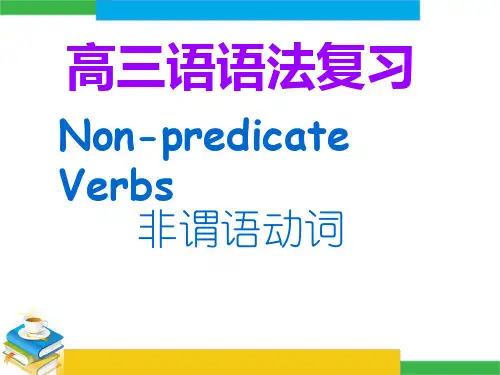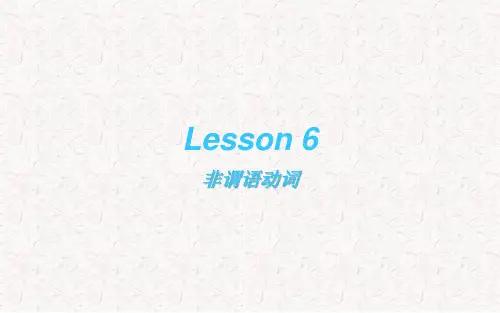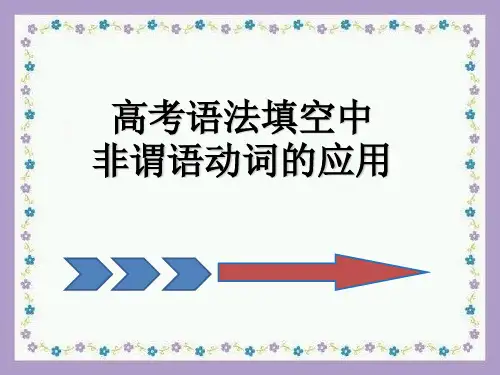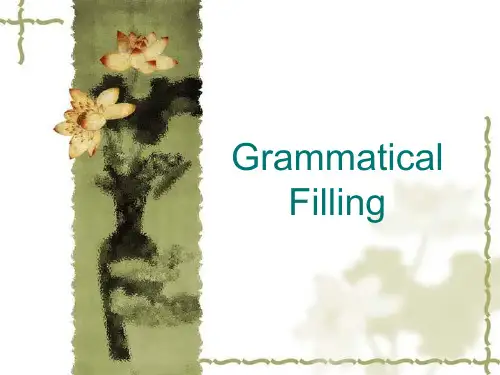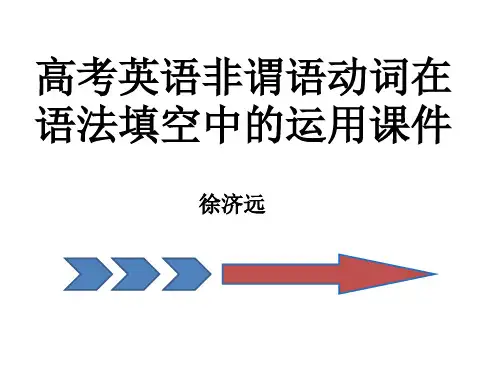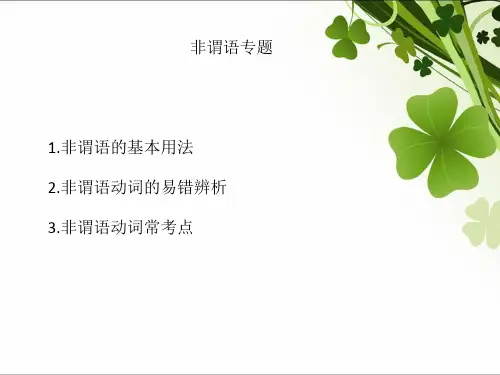- 1、下载文档前请自行甄别文档内容的完整性,平台不提供额外的编辑、内容补充、找答案等附加服务。
- 2、"仅部分预览"的文档,不可在线预览部分如存在完整性等问题,可反馈申请退款(可完整预览的文档不适用该条件!)。
- 3、如文档侵犯您的权益,请联系客服反馈,我们会尽快为您处理(人工客服工作时间:9:00-18:30)。
opinions. It’s no use _a_r_g_u__in__g__(argue) with him.
(上海)
3. Please remain __s_e_a_te_d___(seat); the winner of
the prize will be announced soon. (辽宁)
[例2] While she was getting me ___34___ (settle) into a tiny but clean room…(2007年广东)
分析:因句中已有谓语was getting,所以 settle应是非谓语动词;又由settle sb. into/in/on…(使某人舒服地处于某处)可知, me与settle是被动关系,要用过去分词用宾 语 (1)动词不定式作定语:常放在所修饰的名词 之后,表示一个将来的动作,多用来修饰have、 there be、with之后的名词,表示“有…… 要……”;或修饰“the+序数词”。
(2)分词作定语:被修饰的名词与分词是主动 关系,用-ing形式,是被动关系时用-ed形式。
考点7:特殊句式 Why not do sth.? =Why don’t you do sth.?何不做某事呢?
have a hard time in doing sth.做某事很艰难 there is no sense in doing做……是没有理由/ 道理的
(7)介词后一般只能接动名词,但在表示 “除……外”的介词but和except后,有时可 接不定式;当前面有行为动词do时,不定式 不带to;前面没有行为动词do时,要带to。
考点4:作宾补 当宾语与作宾补的动词在逻辑上是主动关系 时,用不定式(未来或全过程)或-ing形式(正在 进行或一直处于某种状态); 当宾语与作宾补的动词在逻辑上是被动关系 时,用-ed形式。
请注意复习以下6点: (1)在ask, invite, encourage, advise, forbid, remind等动词后,用带to的不定式作宾补。 (2)在help后作宾补的不定式带不带to均可。
had better (not) do sth.最好(不)做某事
would rather (not) do sth.宁愿(不)做某事 would do A rather than do B = would rather do A than do B = prefer to do A rather than do B = prefer doing A to doing B
— Oh, yes. How often I have regretted
__n_o_t__ta_k__in__g_(not take) his advice! (安徽)
10. If you think that treating a woman well
means always _g_e_t_ti_n_g__ (get) her permission for
6. I can’t stand _w_o_r_k__in__g_(work) with Jane in the same office. She just refuses _t_o__s_to__p_(stop)
talking while she works. (北京)
7. As a result of the serious flood, two-thirds of the buildings in the area need _to__b_e_r_e_p_a_i_r_e_d_ (repair). (陕西)
高三英语总复习语法填空专题训练课件:非谓语动词
非谓语动词
非谓语动词是语法填空的必考考点, 每年高考至少有1道题。不仅如此,掌 握非谓语动词的基本用法,对增强书面 表达的文采和提高阅读理解能力都有明 显的作用。
首先,我们回顾一下非谓语动词的语 法功能(在句中充当何种成分):
主语
宾语
表语
定语
状语
宾补
宁做A事不做B事
考点8:独立结构 (1) -ing形式的独立成分:judging by /from(根据…判断), generally speaking(一般 说来),strictly speaking(严格说来), frankly speaking(坦率地说)等。 (2)不定式的独立结构:to tell you the truth(和你说实话吧), to make things worse(情况更糟的是)等。 (3)用作介词或连词的considering(考虑到, 就…而言)和given(考虑到)后接名词或that从 句。
动名词 √
√
√
√
不定式 √
√
√
√
√
√
分词
√
√
√
√
现在,我们简要回顾其主要考点:
考点1:作主语 表示一般的、泛指的或习惯性的行为用-ing; 表示具体的、一次性的或将来的动作用to do 。 考点2:作表语 (1) 动名词和不定式作表语说明主语的具体内 容。
(2)分词作表语则说明主语的性质,像puzzling, surprising, exciting等-ing分词表示“令人…… 的(事物)”;像puzzled, surprised, excited等-ed 分词表示“(人)感到……的”。
(3)在make, let, have等使役动词和feel, smell, hear, see, watch等感官动词后,一般用不带to
的不定式作宾补,但在其被动式后作主语补足 语时,要加上to。 (4)在with的宾语后,若用-ed形式,表示宾语与 -ed形式在逻辑上是被动关系,且意味着该动作 已经完成;若用-ing形式,表示宾语与-ing形式 在逻辑上是主动关系,且表示动作持续进行。
(5)get sb. to do sth. =have sb. do sth.使某人做某 事(主动、将来); get/have…doing使……处于某一 状态中(主动、持续); get…done=have sth. done请 人做/遭受(被动)。
(6) make oneself 后常用understood, heard, seen, known等作宾补,表示让别人明白自己的意思/让 自己讲的话被别人听到/让自己被别人看到/让自 己被别人认识。
考点3:作宾语 (1)有些动词只能用不定式作宾语。如refuse, expect, promise, decide, offer, pretend等。(类 似动词和短语动词还有哪些?请补上) (2)有些动词只能用动名词作宾语。如:keep,
allow, finish, enjoy, mind, practice, avoid,
而产生的自然结果(同时发生),谓语动词与现在分 词的动作是因果关系。
(4)在作表语的形容词后或者作宾补的 形容词后作状语,一般只用不定式。
(5)表示目的时只能用不定式,此时的 不定式可以放在句首。
(6) 在“连词(如when, while, if, though 等)+分词”结构中,当分词与主句主语 是主动关系时用-ing形式,是被动关系时 用-ed形式。
4. — Can I smoke here?
— Sorry. We don’t allow __sm__o_k__in__g__(smoke)
here. (江苏)
5. It is difficult to imagine his _a_c_c_e_p_t_in_g
(accept) the decision without any consideration. (陕西)
admit, advise, consider, imagine, appreciate, escape, suggest等。(类似动词和短语动词还有 哪些?请补上)
(3) 在表示“需要”的need, want和require等 后用-ing形式的主动形式表示被动意义,也可 用不定式的被动式。
(4)在forget, remember, regret, mean, try等 动词后既可接动名词,也可接不定式,但意 义差别较大。
8. Susan wanted to be independent of her
parents. She tried __li_v_i_n_g__ (live) alone, but she
didn’t like it and moved back home. (湖南)
9. — Robert is indeed a wise man.
[例1]…the proverb, “plucking up a crop 32 (help) it grow”, is based on the following story.
(2008年广东)
分析:因句中已有谓语is based,而“plucking up a crop 32 (help) it grow”是the proverb 的同位语,是一个名词短语而非同位语从句, 因此,help应是非谓语动词;“帮助禾苗长” 是“将禾苗拨起来”的目的,作目的状语,用 动词不定式,故填to help。
(6)含介词的固定句式: prevent /stop /keep sb. /sth. from doing 阻 止……做……
spend /waste time or money in doing 在 做……方面花费/浪费时间或金钱
have some difficulty/trouble in doing 在 做……方面有些困难
(5)在介词之后用动名词作宾语。注意to是介 词的短语,如be /get used to, be accustomed to(习惯于), contribute … to …, devote oneself
to /be devoted to, get down to, look forward to 等。

